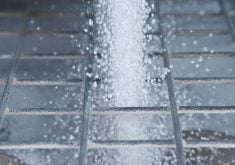Using lime to raise pH levels and rehabilitate acidic soil provides a major benefit for some crops but doesn’t affect others.
Some of the top canola growing areas around Edmonton have been hit hard by clubroot.
In addition to the usual list of tools used in fighting such a disease, researchers at the University of Alberta wanted to see if raising soil pH might help the struggling plants.
They conducted soil liming trials on canola fields in 2007 and 2008 in conjunction with Alberta Agriculture, Agriculture Canada and the Canola Council of Canada, said Steve Stelkov, one of the U of A scientists working on the project.
Read Also

Fall rye hits record high in Manitoba
Winter cereals 2025: More Manitoba fields grew fall rye in 2025 than ever before, but winter wheat slipped and, while spring stand survival was good, drought took its toll
“Lime contributed somewhat to a reduction in the severity of clubroot but not to the extent that it was economically viable to do the treatment,” Stelkov said.
“The plants looked better, but there was not much yield gain. It’s certainly no magic bullet.”
Researchers did notice that clubroot appears to be more severe in naturally acidic soil with low pH, but the benefit of raising the pH level with lime was not as strong as they would have expected, based on the literature and reports from other areas.
Stelkov said there may be little relationship between clubroot and soil acidity. The team found severe clubroot in fields with no sign of acidity and pH levels as high as 7.4.
“Clubroot is those fields is a result of short canola rotations,” he said.
“It has nothing to do with acidity. When we looked at the data, there was only a very small correlation between pH and clubroot. Besides, liming the soil is very expensive. It’s uneconomical to try to improve soil pH to the extent that it would have a benefit, especially on large acreage crops like canola.
“However, it may be economically viable on smaller plot crops such as vegetables.”
Next week, The Western Producer’s Production section will feature a project using waste lime from a municipal water treatment plant to raise the pH level of potato land.














